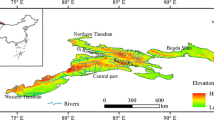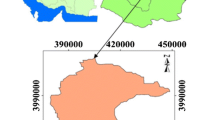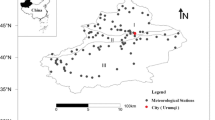Abstract
Warming of the climate system is unequivocal, and the change of climate variables will eventually have a great impact on vegetation cover and agricultural practices, especially in the arid area Xinjiang in China, whose agriculture and ecosystems are heavily vulnerable to climate change. In this paper, normalized difference vegetation index (NDVI) was used to study the vegetation growth and its response to climate change in Xinjiang. Firstly, two NDVI datasets (Global Inventory Modeling and Mapping Studies (GIMMS) and Moderate Resolution Imaging Spectroradiometer (MODIS)) were merged through a pixel-wise regression analysis to obtain a long time series of NDVI data, and then, relationships between yearly NDVI and yearly climate variables, and monthly NDVI and monthly climate variables were extensively investigated for grassland and cropland in northern and southern Xinjiang, respectively. Results show the following: (1) there was an increasing trend in NDVI for both grassland and cropland in both northern and southern Xinjiang over the past decades and trends were significant except that for grassland in northern Xinjiang; (2) precipitation and evaporation were more important than temperature for grassland in northern Xinjiang, while precipitation and temperature were more important than evaporation for grassland in southern Xinjiang and cropland in both northern and southern Xinjiang; (3) NDVI was highly correlated with accumulated monthly precipitation instead of monthly precipitation, and there was a lagged effect of precipitation, temperature, and evaporation on NDVI change. However, lagged effects were only significant in specific months. The results could be helpful to agricultural practices; e.g., based on lagged effect of precipitation, irrigation in July is very important for crop growth.






Similar content being viewed by others
References
Allen RG, Pereira LS, Raes D, Smith M (1998) Crop evapotranspiration—guidelines for computing crop water requirements-FAO irrigation and drainage paper no. 56 [M]. Rome: Food Agricu Org United Nations 52–77:84–86
Badreldin N, Frankl A, Goossens R (2014) Assessing the spatiotemporal dynamics of vegetation cover as an indicator of desertification in Egypt using multi-temporal MODIS satellite image. Arab J Geosci 7:4461–4475
Cao XM, Chan X, Bao AM, Wang Q (2011) Response of vegetation to temperature and precipitation in Xinjiang during the period of 1998–2009. J Arid Land 3(2):92–134
Fensholt R, Rasmussen K, Nielsen TT, Mbow C (2009) Evaluation of earth observation based long term vegetation trends—intercomparing NDVI time series trend analysis consistency of Sahel from AVHRR GIMMS, Terra MODIS and SPOTVGT data. Remote Sens Environ 113(9):1886–1898
Guo N, Zhu YJ, Wang JM, Deng CP (2008) The relationship between NDVI and climate element for 22 years in different vegetation areas of northwest China. J Plant Ecol 32(2):319–327 (In Chinese)
Guo LH, Wu SH, Zhao DS, Yin YH, Leng GY, Zhang QY (2014) NDVI-based vegetation change in Inner Mongolia from 1982 to 2006 and its relationship to climate at the biome scale. Adv Meteorol 2014:1–12
Holben B (1986) Characteristics of maximum-value composite images from temporal AVHRR data. Int J Remote Sens 7(11):1417–1434
IPCC (2013) Summary for policymakers. In: Stocker TF, Qin D, Plattner GK, Tignor M, Allen SK, Boschung J, Nauels A, Xia Y, Bex V, Midgley PM (eds) Climate change 2013: the physical science basis. contribution of working group I to the fifth assessment report of the intergovernmental panel on climate change. Cambridge University Press, Cambridge, United Kingdom and New York
Ji L, Peters AJ (2004) A spatial regression procedure for evaluating the relationship between AVHRR-NDVI and climate in the northern Great Plains. Int J Remote Sens 25(2):297–311
Kelly AE, Goulden ML (2008) Rapid shifts in plant distribution with recent climate change. Proc Natl Acad Sci U S A 105(33):11823–11826
Li XB, Shi PJ (2000) Sensitivity analysis of variation in INDVI, temperature and precipitation in typical vegetation types across China. Acta Phytoecologica Sinica 24(3):379–382
Li B, Tao S, Dawson RW (2002) Relations between AVHRR NDVI and ecoclimatic parameters in China. INT J Rem Sens 23(5):989–999
Li XH, Shi QD, Guo J, Bayindala CSL, Qi JG (2009) The response of NDVI to climate variability in northwest arid of China from 1981 to 2001. J Arid Land Res Environ 23(2):12–16 (In Chinese)
Mao DH, Wang ZM, Luo L, Ren CY (2012) Integrating AVHRR and MODIS data to monitor NDVI changes and their relationships with climatic parameters in Northeast China. Int J Appl Earth OBS 18:528–536
McGwire K, Minor T, Fenstermaker L (2000) Hyperspectral mixture modeling for quantifying sparse vegetation cover in arid environments. Remote Sens Environ 72(3):360–374
Mu SJ, Yang HF, Li JL, Chen YZ, Gang CC, Zhou W, Ju WM (2013) Spatiotemporal dynamics of vegetation coverage and its relationship with climate factors in Inner Mongolia, China. J Geogr Sci 23(2):231–246
Myneni RB, Keeling CD, Tucker CJ, Aarar G, Nemami RR (1997) Increased plant growth in the northern high latitudes from 1981 to 1991. Nature 386:698–702
Olusegun CF, Adeyewa ZD (2013) Spatial and temporal variation of normalized difference vegetation index (NDVI) and rainfall in the north east arid zone of Nigeria. Atmospher Clim Sci 3(4):421–426
Peng J, Liu YH, Shen H, Han YN, Pan YJ (2012) Vegetation coverage change and associated driving forces in mountain areas of Northwestern Yunnan, China using RS and GIS. Environ Monit Assess 184:4787–4798
Piao SL, Fang JY, Zhou LLM, Guo QH, Henderson M, Ji W, Li Y, Tao S (2003) Interannual variations of monthly and seasonal normalized difference vegetation index (NDVI) in China from 1982 to 1999. J Geophys Res D 108(14):1–13
Piao SL, Mohammat A, Fang JY, Cai Q, Feng JM (2006) NDVI-based increase in growth of temperate grasslands and its responses to climate changes in China. Glob Environ Chang 16:340–348
Pu ZC, Zhang SQ, Wang SL, Zhou XL, Feng ZM (2011) The spatial-temporal variation characteristic of dry-wet climate in recent 48 years in Xinjiang province, China. J Desert Res 31(6):1563–1572
Richard Y, Poccard I (1998) A statistical study of NDVI sensitivity to seasonal and interannual rainfall variations in Southern Africa. INT J Rem Sens 19(15):2907–2920
Schmidt M, Klein D, Conrad C, Dech S, Paeth H (2014) On the relationship between vegetation and climate in tropical and northern Africa. Theor Appl Climatol 115:341–353
Shi YF, Shen YP, Kang E, Li DL, Ding YJ, Zhang GW, Hu RJ (2007) Recent and future climate change in northwest China. Clim Change 80(3–4):379–393
Slayback DA, Pinzon JE, Los SO, Tucker DA (2003) Northern hemisphere photosynthetic trends 1982–1999. Global Change Biol 9:1–15
Statistical Bureau of Xinjiang Uygur Autonomous Region (2010) Xinjiang statistical yearbook 2010. China Statistical Press: Beijing, 2010 (In Chinese)
Steven MD, Malthus TJ, Baret F, Xu H, Chopping MJ (2003) Intercalibration of vegetation indices from different sensor systems. Remote Sens Environ 88:412–422
Vicente-Serrano SM, Beguería S, López-Moreno JI (2010) A Multi-scalar drought index sensitive to global warming: the standardized precipitation evapotranspiration index—SPEI. J Clim 23:1696–1718
Wang HJ, Chen YN, Shi X, Lai DM, Fan YT, Li Z (2013) Changes in daily climate extremes in the arid area of northwestern China. Theor Appl Climatol 112:15–28
Wang YF, Shen YJ, Sun FB, Chen YN (2014) Evaluating the vegetation growing season changes in the arid region of northwestern China. Theor Appl Climatol 118:569–579
Xin ZB, Xu JX, Zheng W (2008) Spatiotemporal variations of vegetation cover on the Chinese Loess Plateau (1981–2006): impacts of climate changes and human activities. Sci Chin Ser D-Earth Sci 51(1):67–78
Yang Y, Xu JH, Hong YL, Lv GH (2012) The dynamic of vegetation coverage and its response to climate factors in Inner Mongolia, China. Stoch Environ Res Risk Assess 26:357–373
Zhang SJ, Wang T, Wang TM, Lu AG, Ge JP (2009) The Variations in NDVI of different vegetation types in Xinjiang and its relation to climate factors. Pratacult Sci 26(5):26–31 (In Chinese)
Zhao X, Tan K, Fang JY (2011) NDVI-based interannual and seasonal variations of vegetation activity in Xinjiang during the period of 1982–2006. Arid Zone Res 28(1):10–16
Acknowledgments
The research was supported by the “Thousand Youth Talents” Plan (Xinjiang Project). GIMMS NDVI dataset and land use data were downloaded from Environmental and Ecological Science Data Center for West China (http://westdc.westgis.ac.cn). Authors would like to thank Prof. Bodo Ahrens and two anonymous reviewers for their constructive comments which significantly improved the manuscript.
Author information
Authors and Affiliations
Corresponding author
Rights and permissions
About this article
Cite this article
Xu, Y., Yang, J. & Chen, Y. NDVI-based vegetation responses to climate change in an arid area of China. Theor Appl Climatol 126, 213–222 (2016). https://doi.org/10.1007/s00704-015-1572-1
Received:
Accepted:
Published:
Issue Date:
DOI: https://doi.org/10.1007/s00704-015-1572-1




